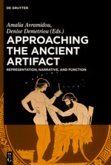Shaping, measuring and perceiving time has become crucial within the social fabric of most cultures. The book explores from the fifth century B. C. to late antiquity what types of chronometers came into use and how they measured time; when, where and why they became part of the societies of Greece and Rome; and by and for whom they were commissioned, designed and set up. For this purpose for the first time, some 500 chronometric instruments and their inscriptions from all over the classical world have been brought together to scrutinise questions such as form, typology, chronology, setting, function and context. Sundials constitute the majority of the material (c. 80%), followed by various types of chronometers, mainly water clocks. The particular contextual approach made it possible to define individuals and groups of people linked to time measurement; and, in consequence, to determine at least some of the primary functions of the chronometers set up in the societies of ancient Greece and Rome.
Der Umgang mit Zeit zählt zu den gesellschaftlichen Konstanten, die eine Kultur definieren. Der vorliegende Band analysiert für die Kulturen Griechenlands und Italiens den antiken Umgang mit Zeitmessung im Rahmen einer kulturgeschichtlichen Untersuchung. Dafür werden über 500 Zeugnisse, vor allem Sonnenuhren, in Form eines Kataloges zusammengetragen. Neben einer forschungsgeschichtlichen Einleitung bietet der Band eine Typisierung des Materials. Weiterführende Studien interpretieren Dekorformen und Inschriften, auch in Epigrammform, auf den Zeitmessern. Der kontextuelle Ansatz, durch den die Einzelinformationen genutzt werden, um funktionale Fragen zu beantworten, erlaubt es erstmals Aussagen über die mit Zeitmessung verbundenen Personengruppen zu formulieren, wie z.B.: In welche Aktionen und Handlungsabläufe sind die Geräte am jeweiligen Ort eingebunden? Wann bleibt die Wahrnehmung des technischen Mediums auf einen engen Expertenkreis beschränkt und wann tritt es ins Bewusstsein einer erweiterten Öffentlichkeit?
Hinweis: Dieser Artikel kann nur an eine deutsche Lieferadresse ausgeliefert werden.
Der Umgang mit Zeit zählt zu den gesellschaftlichen Konstanten, die eine Kultur definieren. Der vorliegende Band analysiert für die Kulturen Griechenlands und Italiens den antiken Umgang mit Zeitmessung im Rahmen einer kulturgeschichtlichen Untersuchung. Dafür werden über 500 Zeugnisse, vor allem Sonnenuhren, in Form eines Kataloges zusammengetragen. Neben einer forschungsgeschichtlichen Einleitung bietet der Band eine Typisierung des Materials. Weiterführende Studien interpretieren Dekorformen und Inschriften, auch in Epigrammform, auf den Zeitmessern. Der kontextuelle Ansatz, durch den die Einzelinformationen genutzt werden, um funktionale Fragen zu beantworten, erlaubt es erstmals Aussagen über die mit Zeitmessung verbundenen Personengruppen zu formulieren, wie z.B.: In welche Aktionen und Handlungsabläufe sind die Geräte am jeweiligen Ort eingebunden? Wann bleibt die Wahrnehmung des technischen Mediums auf einen engen Expertenkreis beschränkt und wann tritt es ins Bewusstsein einer erweiterten Öffentlichkeit?
Hinweis: Dieser Artikel kann nur an eine deutsche Lieferadresse ausgeliefert werden.








